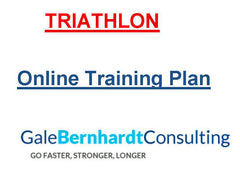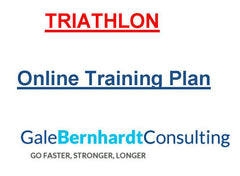Description
Triathlon: Half-Ironman (70.3) triathlon race plan, Intermediate: 7.25 to 14.25 hrs/wk
Author: Gale Bernhardt
12 weeks - $64.95 (There is a 10% discount when ordering from Gale Bernhardt’s website.)
Total Hours: 119
Are you an experienced and fit triathlete looking for a new challenge, maybe a longer race? Well how about a half-Ironman distance event? This 12-Week plan might be just what you need, read on.
You are a triathlete with experience at sprint and Olympic-distance racing. You keep in good condition most of the year. You currently swim two to three times per week and this may or may not be with a masters team. You are cycling two to three days per week and a two-hour ride is normal for you. You run two to three days per week, with the long run of the week lasting about an hour. Strength training may or may not be part of your weekly routine. A suggested strength training routine is included in the plan for athletes wanting to compliment their endurance training with strength training.
In short, you think of yourself as an intermediate triathlete with a good base of swimming, cycling and running. You've thought about racing longer distances, but just haven't gotten around to making yourself a plan. If this description fits you, this may be the plan you’ve been looking for.
You can view a sample week of training below. Throughout the plan, weekly training hours range from 7:15 to 14:15. This plan builds the long run to 2:15 and the long ride to 4:30. This plan includes more weekly training volume and more workout time at higher intensities than does the 13-Week Half-Ironman Distance Beginner Plan.
Q & A
Q – I see “Workouts in a Binder” mentioned on the swimming instructions preview, do I need to purchase that product to successfully complete the program?
A – Swimming is a bugger for several reasons. One is that some people prefer swimming with a masters group and do not want specific workouts for the swim portion of the plan. They want guidelines for what kind of intensity to hold during the masters workout. Others prefer suggested workouts, but they want to modify any suggestion to meet personal needs. (Because people with a swimming background can complete significantly more yards during a particular one-hour swim workout than a beginning swimmer can.)
Additionally, I don’t want athletes paying for something they don’t need.
For the reasons stated above, I did not bundle a purchase of “Workouts in a Binder for Triathletes” with individual training plans; but left that product as an optional purchase, available at in my online store and many major book and triathlon retailers. This product has totally waterproof workout pages designed with two levels for each workout. Those levels can also be modified to meet the needs of shorter workouts. This design was conceived to eliminate the frustration associated with printing workouts onto paper, putting them in a baggie, only to get mid-way through the set and find water leaked into the bag and destroyed the workout.
Q – What if I don’t like the plan once I’ve seen it?
A – Because discounted plans are offered through this site and a coding system, no refunds are allowed. If you are worried about wanting or needing a refund, you can forego the discount and purchase the plan directly from the TrainingPeaks website. Refunds for training plans are offered for a limited time after purchase. You can find this training plan on that site by following this link.
Q – What do I get with a training plan?
A – After purchase, your plan will be available in your own private online training log account. You will enjoy the following benefits and more:
Daily e-mails with your next workout keep you on track
Create your own routes or search the library of routes for tracking your workouts
Map, graph and share workouts with your friends by e-mail, Facebook and view in Google Maps or Google Earth
Upload workouts from one of more than 80 training devices (Garmin, Suunto, Timex, Polar, more) or easily record your workouts manually
Track your fitness and gain confidence
Complete nutrition tracking to monitor your diet
Get support and answers on a message board specific to your plan and access to more message boards

Sample workouts:
Workout #1 : Strength
Planned Time: 1:00:00
Warm up cycling or running 10-30 minutes. For each of the designated exercises, complete 1 set of 20 reps at a light weight, increase the weight and do 1-2 sets x 12 reps, increase the weight and do 1-2 sets x 6-8 reps. For the remaining exercises, complete 2-3 sets of 12 - 15 reps. Decrease the sets and weight in heavy racing periods.
Workout #2 : Swim
Planned Time: 1:00:00
BT: This workout utilizes your T1-pace for the main set. The main set is some combination of distances lasting 20 to 40 minutes, with a good portion of the set at T1-pace or slightly (two to five seconds) faster. Swim segments might be 50 to 200 yards or meters long and depending on the length of each swim, rest intervals are five to 20 seconds long. The goal is to sustain T1-pace, or slightly faster. These workouts are often referred to as lactate threshold or anaerobic threshold workouts and it is important to be well rested heading into a muscular-endurance session. Select Workouts in a Binder (M) card.
Workout #3 : Run
Planned Time: 0:30:00
Run a flat to gently rolling course in heart rate Zones 1 to 2. No need to "push" Zone 2. Within the run, check leg speed a few times by counting your left foot strikes for 15 seconds. The total should be 21 or more.
Workout #4 : Bike
Planned Time: 0:45:00
This workout helps work the dead spot out of pedal stroke. After a warm-up, with light resistance on an indoor trainer, do 100 percent of the work with one leg while the other leg is or resting on a stool. The bottom of the stroke is similar to the motion of scraping mud off the bottom of your shoe. The top of the stroke can be improved by driving toes forward. In all positions, keep the toes relaxed. Do not allow them to curl-up and clinch the bottom of your shoe. (This can be done outdoors by relaxing one leg while the other leg does most of the work.) After doing a work segment with each leg (start with 20-60 seconds per leg), spin easy with both legs for 1-3 minutes and then go back to single legwork. Begin with a cumulative time of 3 to 5 minutes on each leg and build time, as you become stronger.
Workout #5 : Run
Planned Time: 0:45:00
BT: These intervals begin work on lactate threshold speed. On a mostly flat course or treadmill, complete the number of assigned repeats for the minutes indicated on your plan, allowing heart rate to rise into Zone 3 over the course of the interval. Take recovery time as indicated on your plan, between work intervals. Begin timing the interval as soon as effort is increased. After heart rate reaches Zone 3, hold it there until the end of the interval.
Workout #6 : Swim
Planned Time: 0:30:00
The main set will be mostly aerobic work; however a good deal of form work is included at the beginning or the end of the workout. For this workout, speed is less important than good form. Some coaches refer to this as drill work. Neuromuscular training is important during the drill segment. (Can select a Workouts in a Binder card E(Form). )
Workout #7 : Bike
Planned Time: 1:00:00
Ride in the small chain ring at 90 rpm on a flat course, keeping heart rate in Zone 1. If you are unable to maintain 90 rpm, coast and rest until you can resume 90 rpm.
Workout #8 : Swim
Planned Time: 0:45:00
Swim with masters or on your own, control the intensity, so RPE is in Zones 1-2. (Can select a Workouts in a Binder card (E). )
Workout #9 : Run
Planned Time: 1:00:00
This level is used for aerobic maintenance and endurance training. Heart rate should stay primarily in the 1 to 2 zones. How much time is spent in each zone depends on how you feel that day. The goal of an E2 run is not to see how much time you can spend in Zone 2. Run a rolling course if possible, with grades up to 4 percent. For reference, most highway off-ramps are 4-percent grade. Changing the grade on a treadmill, for those living in vertically deficient cities, can simulate hills. If you run with a group, inner discipline is necessary to let the group go if they turn a training run into a race.




